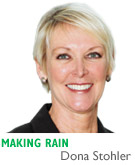Subscriber Benefit
As a subscriber you can listen to articles at work, in the car, or while you work out. Subscribe Now
 “It’s not necessary to change. Survival is not mandatory.” W. Edwards Deming said this many years ago. The management science of quality improvement and change acceleration has evolved since then, but the message still makes sense. Law firms today must change their approach toward business development and marketing and embrace the change.
“It’s not necessary to change. Survival is not mandatory.” W. Edwards Deming said this many years ago. The management science of quality improvement and change acceleration has evolved since then, but the message still makes sense. Law firms today must change their approach toward business development and marketing and embrace the change.
Change is hard. People don’t like it and generally don’t want to do it. Change management requires a process and approach to move people toward accepting and embracing the change. And then making the change last.
Law firms many times decided to change, but the change doesn’t last. They try client teams, but they fizzle away. They try to be better at pushing content, but then enthusiasm wanes. They try to be diligent about getting client feedback and making continuous improvement, but quickly lose interest. The difference between good firms and great ones is that the great ones make change last and look for continuous improvement toward their ultimate goal or objective. They embrace change and know that it is necessary to survive.
The General Electric model
General Electric developed a process years ago that has been adapted by many organizations to not only prepare people for change, but to sustain it. I worked for an RCA division that was acquired by GE when Jack Welch was the CEO. “Neutron Jack” they called him, because he was all about rapid change. But the model developed at GE that we used to manage the changes that came to bear upon us continues to produce the desired results of making change happen and sustaining it over time.
The GE model basically involves arriving at consensus around what needs to change to resolve an issue, make an improvement or break down a barrier. But one thing that is critical for this model to work is passion or urgency. Unless at least 75 percent of the people who can champion the change believe that it is absolutely necessary to “do something differently,” it will never work no matter how hard you try.
The model also requires you have the appropriate person within the organization spearheading or supporting the change. Without this, the change will not succeed. It doesn’t matter how bad the situation or problem, if the key leader doesn’t see a need to resolve it, it won’t get resolved.
The GE model includes a process that typically involves these steps:
Defining the desired outcome. The definition should be measureable and attainable. Additionally, change needs to happen in small increments, so the desired outcome should be something that can be achieved in less than six months. This is achieved, and then you do it all again to take the next small step. This approach allows everyone to adapt a little bit at a time and it helps in sustaining the change.
Hearing from the customer. The customer can be inside the organization or outside, depending upon what you are trying to change. But there is always a customer. There is someone who can tell you what they like or don’t like about the current state. These people can tell you what you are going to have to overcome to make the change happen. Getting input from them is critical to understanding their point of view so that you have the insight you need to reach your desired outcome.
Establishing boundaries. There are certain things or areas that the executive sponsor or key leader may say are off limits. These need to be defined so that the team working on the change knows where they can and cannot tread. If they do not understand the boundaries, they will make recommendations that cannot be implemented.
Developing a plan. Typically a team works on this. The model has tools and techniques that are used to come to consensus around what recommendations are the lowest cost, but give the highest value toward making the change. Or another way to look at it is things that can be changed with the least effort to have the most impact.
Implementation and monitoring. The recommendations are then implemented and progress is measured after the established period of time for the change to ensure that the change has been made.
Wash, rinse, repeat. Keep inching down the road to make continued improvements and make the change last.
The big lesson is that by starting with small steps a great deal can be accomplished. If you try to change too much, the resistance will be so overpowering that it will likely fail. Use data to drive decisions, eliminate defects by getting out the noise and waste, and improve the customer experience. Putting a disciplined process in place to make changes will improve decision-making while focusing on the voice of the customer. Mr. Deming may not have been a fan of David Bowie, and maybe you aren’t either. But turn and face the strange because ch-ch-ch-changes need to be part of your business development and marketing strategies.•
Dona Stohler of S2 Law Firm Strategies provides consulting services on business development and marketing for law firms. Stohler has more than a decade of experience in the legal services industry and is the past chair of the U.S. Law Firm Group marketing committee. She can be reached at [email protected] or through www.S2lawfirmstrategies.com. The opinions expressed are those of the author.
Please enable JavaScript to view this content.
